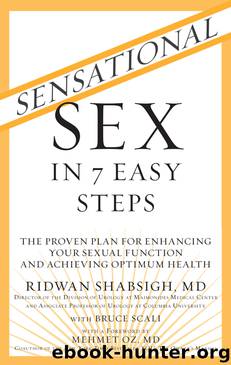Sensational Sex in 7 Easy Steps by M.D. Ridwan Shabsigh

Author:M.D. Ridwan Shabsigh [Ridwan Shabsigh, M.D.]
Language: eng
Format: mobi
Publisher: Potter/Ten Speed/Harmony/Rodale
Published: 2012-04-15T00:00:00+00:00
ERECTILE DYSFUNCTION
According to the 1992 National Institutes of Health Consensus Development Panel on Impotence, erectile dysfunction is defined as “the persistent inability to achieve or maintain an erection sufficient for satisfactory sexual performance.” ED is therefore characterized by insufficient bloodflow to the penis and/or insufficient retention of blood in the penis.
The National Health and Social Life Study (NHSLS) and the Massachusetts Male Aging Study (MMAS) revealed that the prevalence of ED worldwide is 7 percent for men 18 to 29 years old, 9 percent for 30 to 39 years of age, 11 percent for ages 40 to 49, 18 percent for men 50 to 59, and 37 percent for men 60 to 69 years of age. According to current estimates, 30 million men in the United States alone experience ED, and that number is expected to at least double by the year 2025 because of an aging population and increased awareness of the problem.
Although ED is still underreported and undertreated, recent studies have shown that 10 million American men—almost 20 percent of those over age 40—have already been treated for it. It is estimated that there will be over 600,000 new cases every year over the next few years, with even more cases per year down the road.
Our understanding of the causes and risk factors for ED has grown immensely over the past 20 years. It is extremely important to appreciate ED risk factors you might have now that can lead to ED later. Aging alone is an independent risk factor simply because physiologic changes that occur over time cause a progressive decline in sexual function. Testosterone levels decrease markedly with each decade past age 40. The latency period from sexual stimulation to erection increases, erections are less firm, ejaculation is less forceful, and the volume of ejaculate is reduced while the refractory period required to achieve the next erection is longer. There is also a decrease in penile sensitivity to stimulating touch. The incidence of the chronic diseases associated with ED also increases with advancing age. You may not have had any episodes of failure to achieve and maintain an erection, but because there is a high correlation of these factors with ED, no matter how old you are, the more of them you have—and the more serious they are—the more likely you will develop a problem with your erections. If you do have ED, then its cause must be determined before effective treatment can be implemented.
Earlier research had suggested that up to 90 percent of erectile failure had psychogenic origins, but modern diagnostic tools revealed that vascular, neurological, endocrinological, lifestyle, and relationship factors may be the dominant cause. The current consensus is that most patients have a mixture of causes for their ED that may either be predominantly psychogenic or predominantly physical. The comprehensive sexual medicine examination described above will point you and your physician to what needs to be addressed—and how to proceed.
Download
This site does not store any files on its server. We only index and link to content provided by other sites. Please contact the content providers to delete copyright contents if any and email us, we'll remove relevant links or contents immediately.
The Ultimate Guide to Fellatio by Violet Blue(1525)
101 Get-Lean Workouts and Strategies by Muscle & Fitness(1508)
The Penis Book by Aaron Spitz(1448)
The Doctors Book of Home Remedies by Prevention Magazine Editors(1244)
The World's Fittest Book: How to train for anything and everything, anywhere and everywhere by Ross Edgley(1177)
The Book of Pook by Pook(1120)
The Ins and Outs of Gay Sex by Stephen E. Goldstone(1061)
The Men's Health Diet by Stephen Perrine(1031)
What to Eat When by Michael Roizen & Michael Crupain & Ted Spiker(1022)
The HIIT Bible by Steve Barrett(1021)
Flat Belly Diet! for Men by Liz Vaccariello(1013)
Anabolics E-Book Edition by Llewellyn William(999)
The Hook Up Handbook: 28 Fundamentals to Keep Her Coming Back for More by Perrotta David(990)
The Esquire Guide to Bodyweight Training by Adam Schersten(989)
Future Man by Tim Samuels(989)
Younger Next Year by Chris Crowley(971)
Living An Orgasmic Life by Xanet Pailet(970)
The Men's Health Home Workout Bible by Lou Schuler(893)
Dad Bod to Bad Bod: The EXACT Workout and Diet I Followed to Burn Fat and Build Muscle - FAST (Abs, Ab Workouts) by Raza Imam(870)
